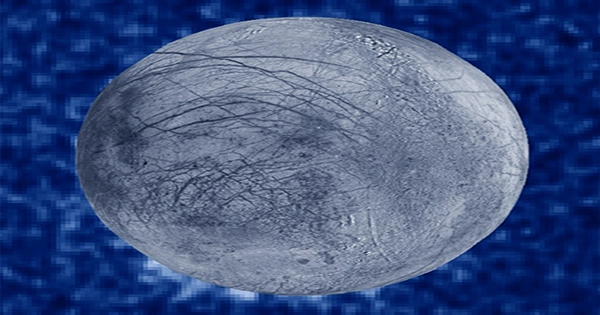The frozen crust of Jupiter’s ice moon Europa hides a deep ocean that may be inhabited. However, researchers now believe that lakes within the moon’s crust may represent a different kind of water storage. The explosions that are taking place on the surface of this frozen world may be caused by these bodies of water.
Large lakes are likely to put stress on the ice around them as their temperature changes, according to new computer simulations. Since water ice is less dense than liquid water, if one of these lakes starts to freeze, the volume will increase and put pressure on the nearby walls.
The pressure may be too much for some of these lakes, causing surface fissures to erupt with water. This could occur as vapor plumes that extend into space or as cryovolcanoes, which are eruptions of salty, slushy ice as opposed to the heated volcanoes that exist on Earth and on the neighboring Jovian moon, Io.
Elodie Lesage, a Europa scientist at NASA’s Jet Propulsion Laboratory, was the study’s principal author. “We demonstrated that plumes or cryolava flows could suggest there are shallow liquid reservoirs underneath, which Europa Clipper would be able to identify,” she said in a statement.
“Our findings provide fresh information on the potential depth of the water that is generating surface activity, including plumes. Additionally, the water should be shallow enough for numerous Europa Clipper detectors to detect it.
NASA’s Europa Clipper mission will fly off in 2024 to investigate this icy moon. The suite of instruments on board the spacecraft should be able to establish the existence of these potential lakes. For instance, the REASON radar for the assessment and sounding of Europa from the ocean to the surface is intended to explore the icy crust.
The model predicts that these reservoirs could be as shallow as 4 to 8 kilometers (2.5 to five miles) below the surface. The thickness of the crust is predicted to range from 10 to 15 miles (15 to 25 kilometers).
According to Don Blankenship, head of the radar instrument team at the University of Texas Institute for Geophysics in Austin, Texas, “the new work shows that water bodies in the shallow subsurface could be unstable if stresses exceed the strength of the ice and could be associated with plumes rising above the surface.” That implies that REASON might be able to detect aquatic bodies where you detect plumes.
















